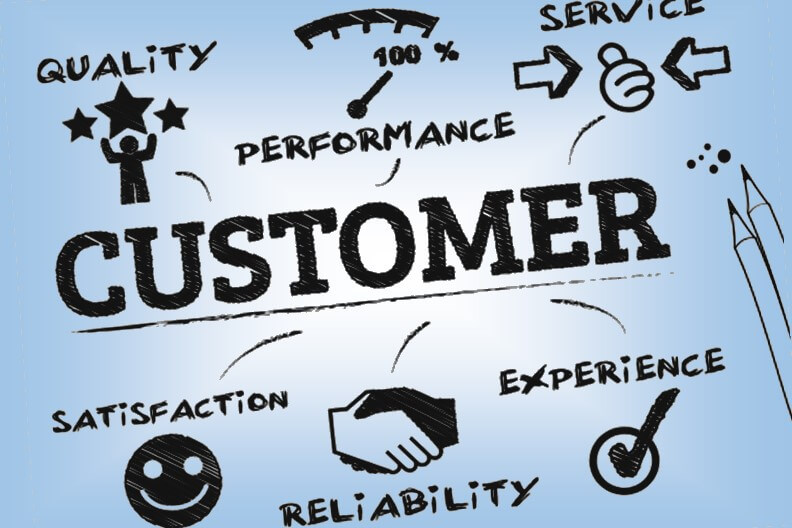This article includes historical information for context. While the core content remains valuable, some details reflect past events and may not be up to date. We regularly update our blog to keep you informed of current insights.
In the past, selling was about delivering on promises – meaning products that work and services that solve problems or generate opportunities. However, customers expect that and much more.
These days, customers want to do business with companies that not only offer ideas that improve their performance but also establish trust with them. Brands that do not rise to the challenge will lose repeat business.
Competition is fierce across industries, and it is in a constant state of flux. Companies that want to outdo their competitors must go beyond simply delivering on promises. They must ensure that their customers’ experience is second to none.
How necessary, exactly, is customer experience?
- 86 percent of buyers are willing to pay more for a great customer experience. (1)
- Customer experience surpasses price and product as the key brand differentiator. (2)
- Eighty-one percent of executives believe they will compete solely based on customer experience very shortly, yet only 22 percent indicate they have developed customer experiences that exceed expectations. (3)
- 62 percent of companies will now invest to meet the changing needs of customers. (4)
- 72 percent of customers will share a positive experience with six or more people, but if the customer is not happy, 13 percent will share their negative experience with 15 or more people. (5)
- When it comes to communication and interaction, trust is essential. Consumers dislike snarky or trendy communication. (6)
- 86 percent of consumers want companies to be honest
- 83 percent desire a warm, friendly demeanor
- 78 percent rate a helpful demeanor as a top priority.
Taking these points into consideration, how can a business create a positive, welcoming, and hassle-free experience for customers?
1. Design a Website That Encourages Interaction and Engagement
If prospects and customers struggle with a brand’s website in any way, they are likely to spend their money elsewhere. Since a website is typically one of the first ways that people interact with a business, designing it to encourage visitor interaction and engagement is critical. Brands should make sure their website has the following characteristics:
- Loads quickly
- Mobile-friendly
- Easy to navigate
- Anticipates visitor questions and needs
Employees in charge of marketing should carefully review and analyze website data, paying particular attention to web pages that are not performing well. From there, they should determine whether these web pages are necessary and, if so, ask for feedback to improve them.
2. Utilize Artificial Intelligence (AI)
Technology, such as smart automation and chatbots, serves two very important purposes: it saves employees the time they used to spend on repetitive tasks and provides a more personalized experience for customers. Other benefits of AI include delivering better customer support, making predictions about sales, providing the right information at the right time during the buyer’s journey, and retargeting customers who have abandoned their purchase. The sky truly is the limit when it comes to leveraging AI.
3. Invest in Employees
Every single staff member in the company, from the lowest-paid employee to the most senior leader, must be on board with the brand’s mission, values, and philosophy. They must also feel valued. Low employee morale and low employee engagement will negatively impact the customer experience.
Ensure that all employees, regardless of title, role, or pay grade, are trained to deliver the best customer experience and are regularly evaluated on the quality of the customer experience they create. These standards should not be limited to external customer experiences. Internal customers – that is, stakeholders such as employees – should also receive a top-notch experience. Positive internal customer experiences enhance teamwork and productivity, reduce employee turnover, minimize absenteeism, and ultimately foster a thriving corporate culture.
4. Obtain Feedback
Managers should actively solicit customer feedback and listen carefully to what customers have to say in response. Contrary to popular belief, a lack of feedback does not mean that customers are happy with the experience.
It is important to remain open to all feedback, including complaints and difficult conversations. Negative feedback can prove extremely valuable in presenting new ideas and ways to improve. Tools such as Mention are also beneficial for locating customer complaints and feedback online, including social networks, forums, and discussion groups.
5. Embrace Technological Tools
While technology can seem intimidating to some, the fact is that technological tools offer compelling benefits. They enable companies to track and measure customer satisfaction, follow buying trends, capitalize on the buyer’s journey, and stay attuned to market-driven needs. Using these tools, brands can connect with prospects on a deeper level. This allows companies to draw prospects to their online properties and, from there, target where they are in their individual journey with the company.
Effective tools to accomplish these goals include the following:
- Marketing automation
- Closed-loop selling
- AI
- Predictive analytics
6. Adhere to Ethics Standards
Building trust with customers is absolutely essential. Brands can do so by taking certain steps to adhere to ethical standards.
The company’s website must comply with the California Consumer Privacy Act of 2018 and with the EU General Data Protection Regulation. Additionally, brands should always be transparent about how they use, share and distribute the data they collect from website visitors and from customers. It is also imperative to follow CAN-SPAM laws that allow subscribers to opt out of their subscriptions. Including a statement on the company’s cookie policy is also a must. Before employees record calls with customers or stakeholders, they should obtain permission, or this should be clearly noted.
Creating a positive customer experience has become crucial for long-term business success. Fortunately, by following these tips, companies can deliver an experience that will make customers return again and again.
For more information about how Gavel International can help your organization through outsourced meeting planning, event, and travel incentive programs, contact us.
____________________________
SOURCES:
1 https://www.pwc.com/us/en/advisory-services/publications/consumer-intelligence-series/pwc-consumer-intelligence-series-customer-experience.pdf
2 http://www.walkerinfo.com/customers2020/
3 https://www.forbes.com/sites/blakemorgan/2018/07/30/why-many-customer-experience-programs-are-still-failing-to-deliver/#11108e7a35d2
4 https://www.walkerinfo.com/Portals/0/Documents/Knowledge%20Center/Featured%20Reports/WALKER-Customers2020.pdf
5 http://www.slideshare.net/ekolsky/cx-for-executives
6 https://www.brandknewmag.com/more-honesty-less-snark-how-consumers-want-brands-to-act-on-social-media/
This article was last updated on July 14, 2025
- 6 Ways to Demonstrate That You Are a Contemporary Leader - July 14, 2025
- Why Hustle Culture Can Harm Sales Success – and How to Repair the Damage - June 30, 2025
- Enhance Sales Through Team-Friendly Storytelling - May 5, 2025






